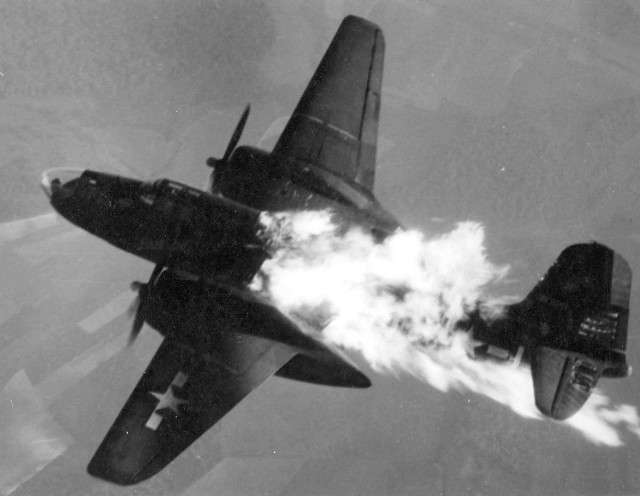 Douglas
A-20J-10-DO (S/N 43-10129) of the 409th or 416th Bomb Group after being
hit by flak over Germany. It burst into flames and crashed a mile west
of the target. Two chutes were seen to come out of the plane. Its crew
was 1st Lt Robert E. Stockwell, pilot, 2d Lt Albert Jedinak,
bombardier-navigator, S/Sgt Hollis A. Foster and S/Sgt Egon W. Rust,
gunners. Lt Stockwell had been with the Group almost from the beginning
of its existence.
Douglas
A-20J-10-DO (S/N 43-10129) of the 409th or 416th Bomb Group after being
hit by flak over Germany. It burst into flames and crashed a mile west
of the target. Two chutes were seen to come out of the plane. Its crew
was 1st Lt Robert E. Stockwell, pilot, 2d Lt Albert Jedinak,
bombardier-navigator, S/Sgt Hollis A. Foster and S/Sgt Egon W. Rust,
gunners. Lt Stockwell had been with the Group almost from the beginning
of its existence.The strategic bombing campaign during WWII cost the lives of roughly 160,000 Allied airmen and 33,700 planes in the European theater alone.
When looking at the RAF, of 7,374 Lancasters built during WWII, 3,349 would be lost in action and the crew had only a one-in-five chance of escaping. For the B-17 crews that number was slightly better, the B-17 had more emergency exits and they had a 3 in 5 chance to make it out.
Regardless of how you feel about the methods used and the goals set, the bravery of the pilots is amazing, getting into their airplanes for a mission knowing the odds.
Wherever possible we have added information to the images about the crews fate. Please note that the reason there are so few RAF pictures in the series is that they flew night missions.
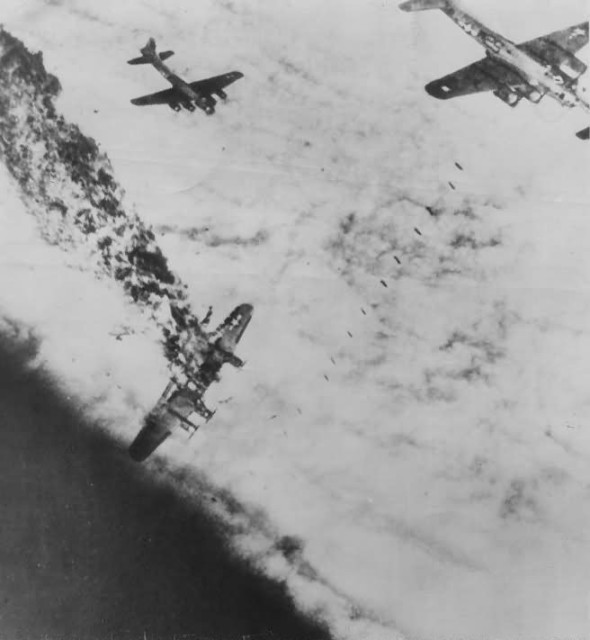 B-17 Flying Fortress 486th BG Merseburg Lutzkendorf November 1944
B-17 Flying Fortress 486th BG Merseburg Lutzkendorf November 1944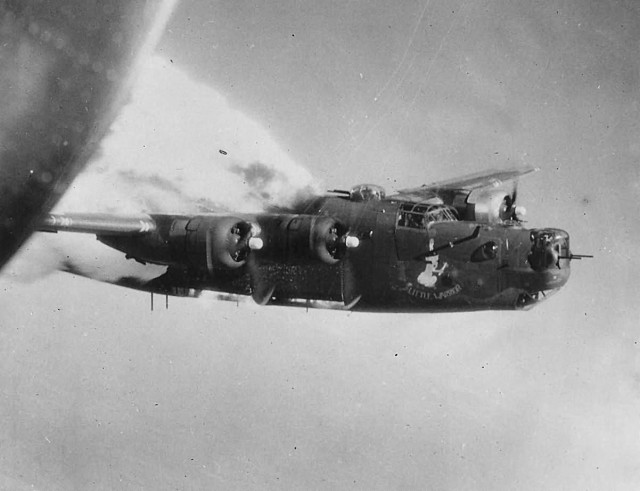 B-24H Liberator 42-94812 “Little Warrior” of the 493rd BG, 861st BS hit by flak over Quakenbrück Germany – June 29, 1944. One crewman managed to bail out safely but was killed by civilians on the ground.
B-24H Liberator 42-94812 “Little Warrior” of the 493rd BG, 861st BS hit by flak over Quakenbrück Germany – June 29, 1944. One crewman managed to bail out safely but was killed by civilians on the ground.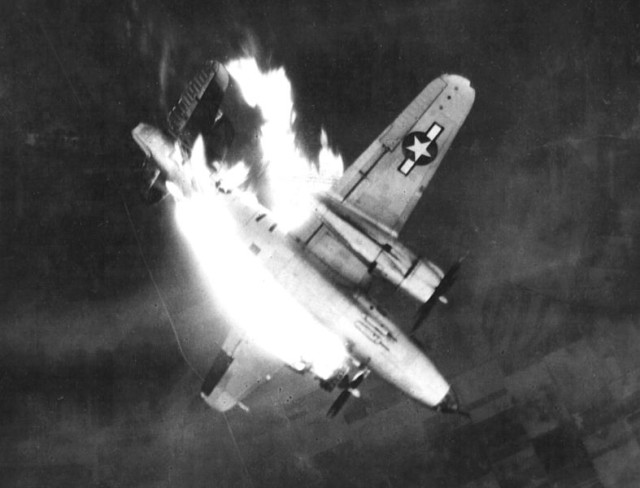 A
U.S. Army Air Forces Martin B-26G-11-MA Marauder (s/n 43-34565) from
the 497th Bombardment Squadron, 344th Bombardment Group, 9th Air Force,
enveloped in flames and hurtling earthward after enemy flak scored a
direct hit on the left engine while aircraft was attacking front line
enemy communications center at Erkelenz, Germany.
A
U.S. Army Air Forces Martin B-26G-11-MA Marauder (s/n 43-34565) from
the 497th Bombardment Squadron, 344th Bombardment Group, 9th Air Force,
enveloped in flames and hurtling earthward after enemy flak scored a
direct hit on the left engine while aircraft was attacking front line
enemy communications center at Erkelenz, Germany.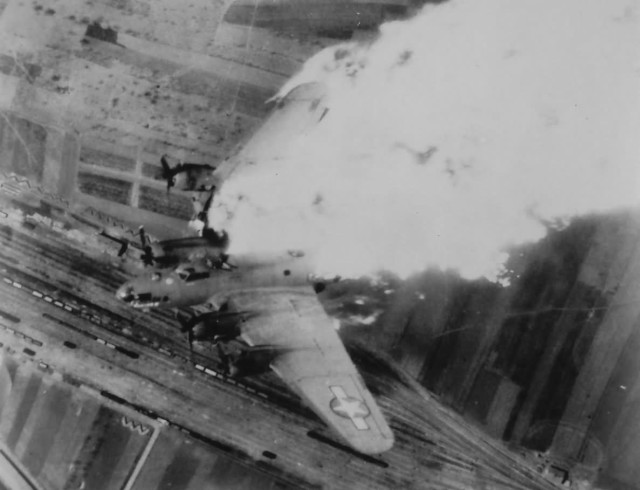 B-17 Flying Fortress Bomber in Flames
B-17 Flying Fortress Bomber in Flames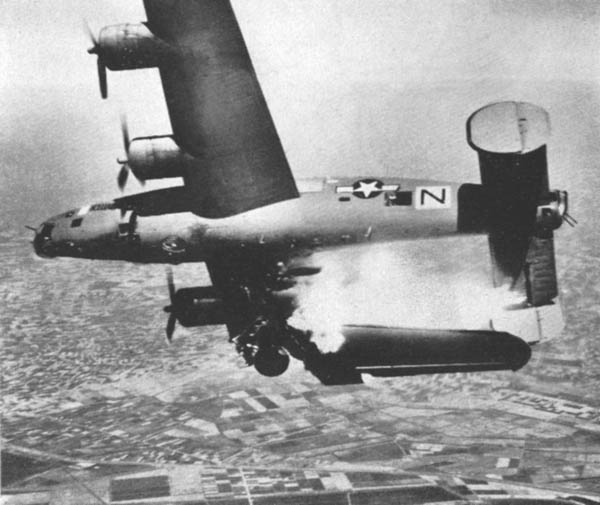 The
U.S. Army Air Force Consolidated B-24L-10-FO Liberator, s/n 44-49710,
named “STEVENOVICH II”, of the 779th Bombardment Squadron, 464th
Bombardment Group, shot down by Flak during an attack on ground troops
near Lugo, Emilia Romagna, Italy, on 10 April 1945.
The
U.S. Army Air Force Consolidated B-24L-10-FO Liberator, s/n 44-49710,
named “STEVENOVICH II”, of the 779th Bombardment Squadron, 464th
Bombardment Group, shot down by Flak during an attack on ground troops
near Lugo, Emilia Romagna, Italy, on 10 April 1945.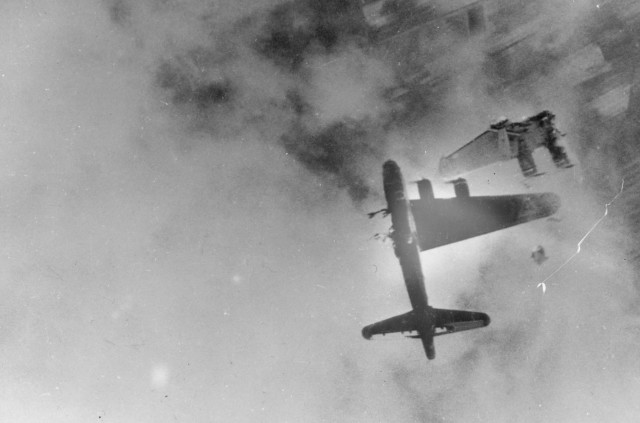 Boeing
B-17G Wee-Willie 42-31333 LG-W, 323th squadron of 91st bombing group,
over Kranenburg, Germany, after port wing blown off by flak. Only the
pilot, Lieutenant Robert E. Fuller, and one crewmember survived.
Boeing
B-17G Wee-Willie 42-31333 LG-W, 323th squadron of 91st bombing group,
over Kranenburg, Germany, after port wing blown off by flak. Only the
pilot, Lieutenant Robert E. Fuller, and one crewmember survived. A B-24M of the 448th Bombardment Group, serial number 44-50838, downed by a Messerschmitt Me 262 jet fighter.
A B-24M of the 448th Bombardment Group, serial number 44-50838, downed by a Messerschmitt Me 262 jet fighter.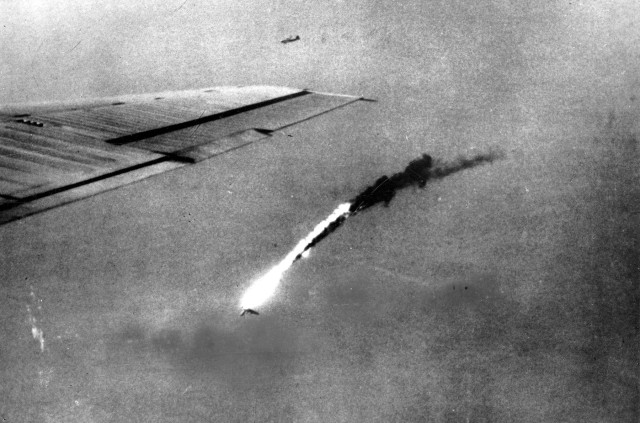 With one wing gone, a B-29 falls in flames after a direct hit by enemy flak over Japan.
With one wing gone, a B-29 falls in flames after a direct hit by enemy flak over Japan.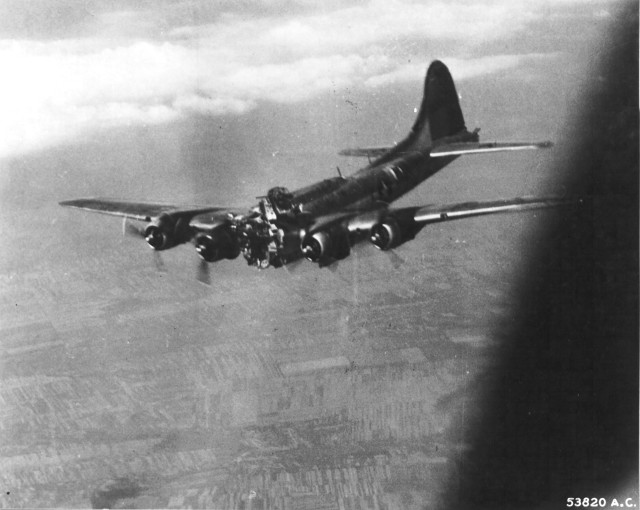 B-17G
Fortress “Mizpah” took a direct AAA hit in the nose on mission to
Budapest, 14 Jul 1944. 2 were killed instantly but the pilot held her
level long enough for crew to get out & become POW’s. The aircraft
crashed near Dunavecse, Hungary
B-17G
Fortress “Mizpah” took a direct AAA hit in the nose on mission to
Budapest, 14 Jul 1944. 2 were killed instantly but the pilot held her
level long enough for crew to get out & become POW’s. The aircraft
crashed near Dunavecse, HungaryContinues on Page 2
Continued from Page 1
 B-24 Liberator in flames not far from Vienna. The crew did not survive.
B-24 Liberator in flames not far from Vienna. The crew did not survive.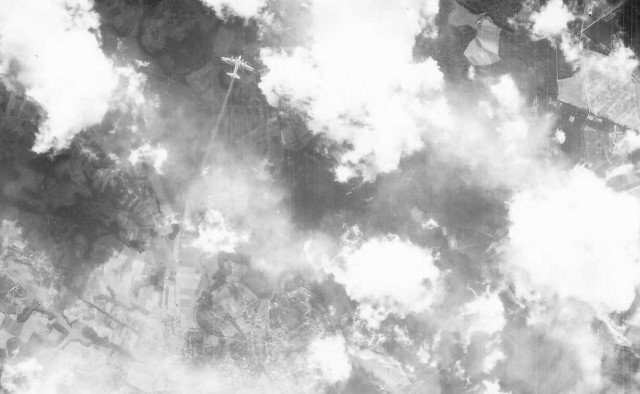 B-17 Bomber Going Down 490th Bomb Group – Monheim Germany
B-17 Bomber Going Down 490th Bomb Group – Monheim Germany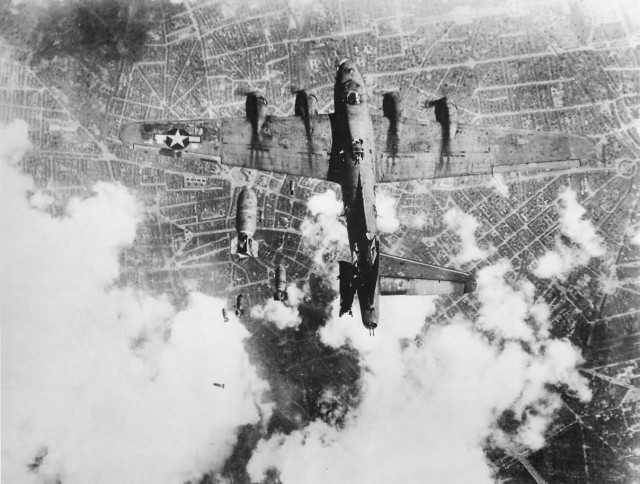 B-17G
Fortress ‘Miss Donna Mae II’ drifted under another bomber on a bomb run
over Berlin, 19 May 1944. A 1,000 lb bomb from above tore off the left
stabilizer and sent the plane into an uncontrollable spin. All 11 were
killed
B-17G
Fortress ‘Miss Donna Mae II’ drifted under another bomber on a bomb run
over Berlin, 19 May 1944. A 1,000 lb bomb from above tore off the left
stabilizer and sent the plane into an uncontrollable spin. All 11 were
killed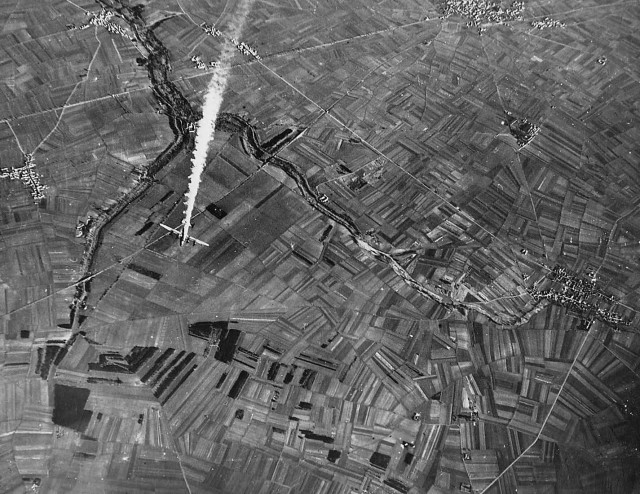 Aerial Photo B-24 Liberator Shot Down Over Germany 1944
Aerial Photo B-24 Liberator Shot Down Over Germany 1944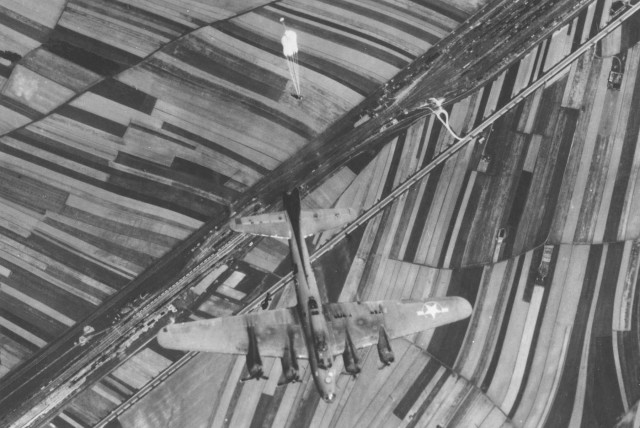 Crew
bails out of damaged B-17F Fortress “Patches” at 22,500 feet over
Wiener Neustadt, Austria, 10 May 1944. 8 of the crew became POWs and the
other 2 were killed. Note 2 right engines feathered
Crew
bails out of damaged B-17F Fortress “Patches” at 22,500 feet over
Wiener Neustadt, Austria, 10 May 1944. 8 of the crew became POWs and the
other 2 were killed. Note 2 right engines feathered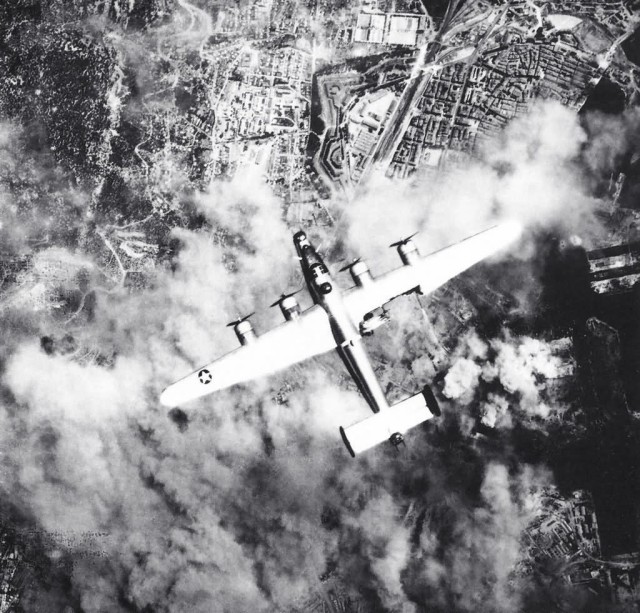 B-24 Bomber Flak Damage, it would not make it home
B-24 Bomber Flak Damage, it would not make it home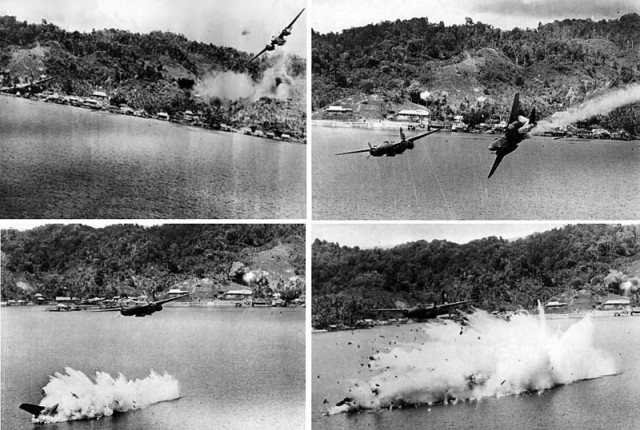 The
crash sequence of a U.S. Army Air Force Douglas A-20G-25 Havoc (s/n
43-9432) during an attack on Kokas, Papua New Guinea, on 22 July 1944.
Twelve A-20s from the 387th Bombardment Squadron, 312th Bombardment
Group attacked the Japanese barge depot and seaplane station at Kokas.
43-9432 (tail code “V”) was part of the last flight over the target.
The
crash sequence of a U.S. Army Air Force Douglas A-20G-25 Havoc (s/n
43-9432) during an attack on Kokas, Papua New Guinea, on 22 July 1944.
Twelve A-20s from the 387th Bombardment Squadron, 312th Bombardment
Group attacked the Japanese barge depot and seaplane station at Kokas.
43-9432 (tail code “V”) was part of the last flight over the target. This section was led by Captain Jack W. Klein (taking the photos), followed by 2nd Lt. Melvin H. Kapson (the other aircraft visible) and 1st Lt. James L. Knarr. Approaching from the inland side, they dropped 115 kg bombs which can be seen exploding in the background. Knarr’s aircraft was hit by antiaircraft fire and crashed into the bay, exploding when it the sea. He and his gunner, SSgt Charles G. Reichley, were killed.
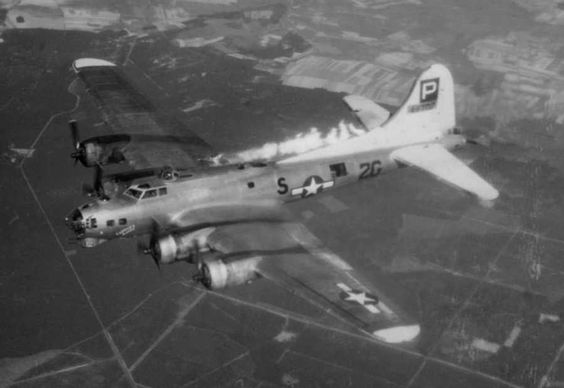 Allied
B-17 of the 836th Squadron 10 April 1945. Cannon shells from a German
Me262 ripped into it’s tail, perforating the vertical stabilizer &
inboard right wing panel. Fire in No 3 engine, flames swept back to the
tail. Peeled off shortly afterwards and dropped behind. Crew bailed out
at RP, 7 miles West of Elbe River. Later right wing came off.
Allied
B-17 of the 836th Squadron 10 April 1945. Cannon shells from a German
Me262 ripped into it’s tail, perforating the vertical stabilizer &
inboard right wing panel. Fire in No 3 engine, flames swept back to the
tail. Peeled off shortly afterwards and dropped behind. Crew bailed out
at RP, 7 miles West of Elbe River. Later right wing came off.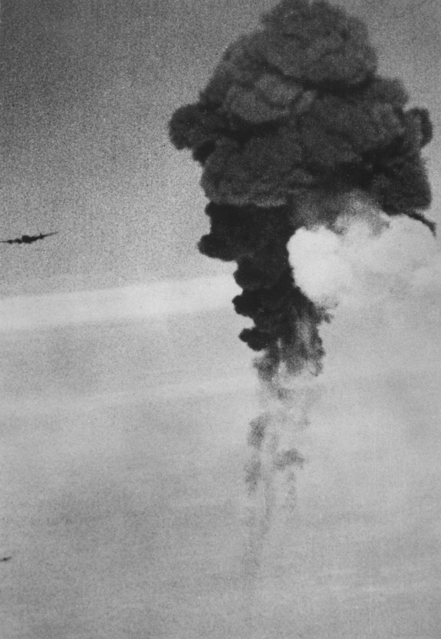 A direct hit by FLAK on a RAF Lancaster bomber in 1945
A direct hit by FLAK on a RAF Lancaster bomber in 1945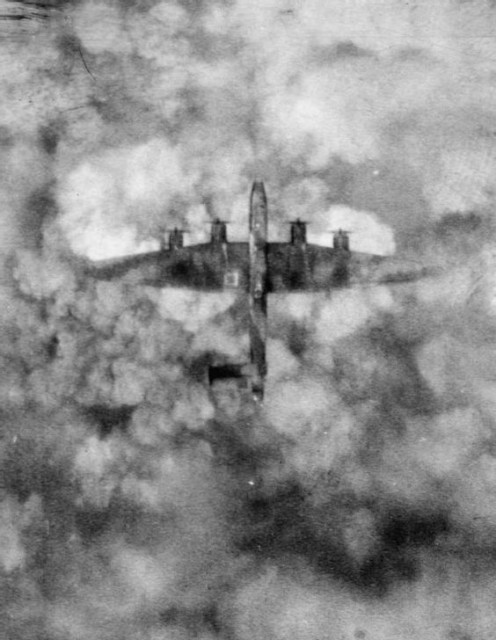 Handley
Page Halifax B Mark III, LW127 ‘HL-F’, of No. 429 Squadron RCAF, in
flight over Mondeville, France, after losing its entire starboard
tailplane to bombs dropped by another Halifax above it. LW127 was one of
942 aircraft of Bomber Command despatched to bomb German-held
positions, in support of the Second Army attack in the Normandy battle
area (Operation GOODWOOD), on the morning of 18 July 1944. The crew
managed to abandon the aircraft before it crashed in the target area.
Handley
Page Halifax B Mark III, LW127 ‘HL-F’, of No. 429 Squadron RCAF, in
flight over Mondeville, France, after losing its entire starboard
tailplane to bombs dropped by another Halifax above it. LW127 was one of
942 aircraft of Bomber Command despatched to bomb German-held
positions, in support of the Second Army attack in the Normandy battle
area (Operation GOODWOOD), on the morning of 18 July 1944. The crew
managed to abandon the aircraft before it crashed in the target area.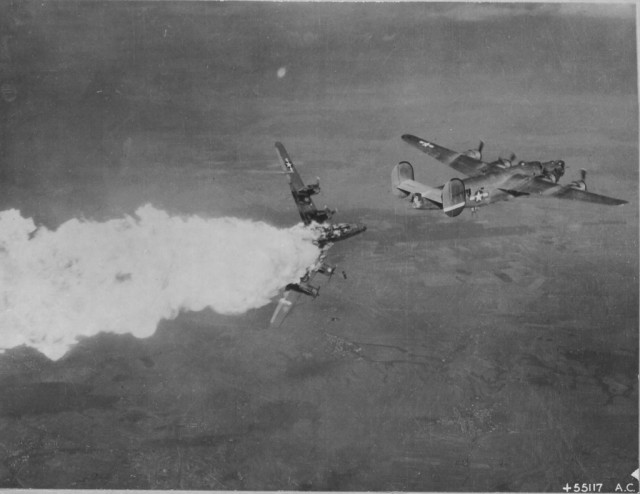 B-24H Liberator bomber of 783rd Bomb Squadron, 465th Bomb Group, US 15th Air Force exploding in mid air after being hit by anti-aircraft fire over Germany, 1944
B-24H Liberator bomber of 783rd Bomb Squadron, 465th Bomb Group, US 15th Air Force exploding in mid air after being hit by anti-aircraft fire over Germany, 1944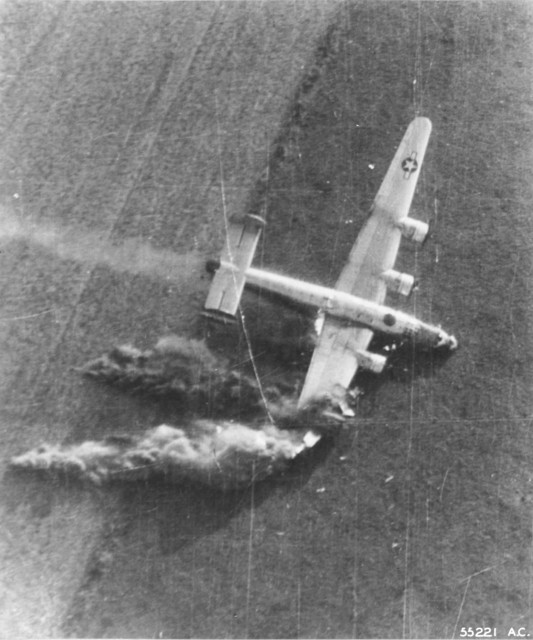 B-24J Liberator of the 854th Bomb Squadron after being hit by light-flak during low-level supply drop for the 82nd and 101st Airborne near Eindhoven, Holland and driven into the ground, Sep 18 1944.
B-24J Liberator of the 854th Bomb Squadron after being hit by light-flak during low-level supply drop for the 82nd and 101st Airborne near Eindhoven, Holland and driven into the ground, Sep 18 1944.Images sources:
US Airforce / NARA images via Wikipedia / WW2DB / WorldWarPhoto

Δεν υπάρχουν σχόλια:
Δημοσίευση σχολίου